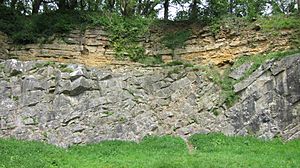Vallis Vale facts for kids
| Site of Special Scientific Interest | |

The De la Beche angular unconformity at Vallis Vale
|
|
| Area of Search | Somerset |
|---|---|
| Coordinates | 51°14′23″N 2°21′08″W / 51.23965°N 2.35234°W |
| Interest | Biological and Geological |
| Area | 23.9 hectares (0.239 km2; 0.092 sq mi) |
| Notification | 1952 |
Vallis Vale is a very special natural area in Somerset, England. It covers about 23.9 hectares, which is like 33 football fields! This place is protected as a Site of Special Scientific Interest (SSSI) because of its amazing plants, animals, and unique rock formations. It was first recognized as a special site in 1952.
Contents
What Makes Vallis Vale Special?
Vallis Vale is an ancient woodland, meaning it has been a forest for a very long time. It's also famous for its incredible rock outcrops. These rocks show some of the clearest examples of something called an angular unconformity. This makes Vallis Vale a super important spot for scientists and students who study geology, which is the science of Earth's rocks and history.
A Special Place for Nature
This ancient woodland is home to many different kinds of trees and plants. It has a specific type of forest called an Ash-Wych Elm stand. This kind of forest is quite rare in Britain, making Vallis Vale an important place for protecting these trees. The old trees and varied plants create a perfect home for lots of wildlife too.
Rocks and Time: A Geological Story
Vallis Vale is like an open-air museum for geology. The rocks here tell an amazing story about Earth's past. Geologists come from all over to study the rock layers. They can see how the Earth has changed over millions of years.
The De la Beche Unconformity
One of the most famous features in Vallis Vale is the De la Beche angular unconformity. Imagine layers of rock that were once flat. Then, something powerful happened, like Earth's plates moving, and these layers got tilted or folded. After a long time, new, flat layers of rock formed on top of the tilted ones. The place where the tilted layers meet the flat layers is an angular unconformity. It shows a big gap in time, like missing pages in a history book, where erosion happened or no new rocks formed. This specific unconformity is named after Henry De la Beche, an important geologist who studied it. It's a classic example used to teach students about Earth's long and complex history.

